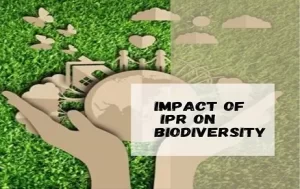The intellectual property (IP) licensing has gone a long way with the pace of technology…
The Impact of IPR on Biodiversity
Introduction to Biodiversity
Biodiversity in simple terms is referred to as the living variety of plant and animal life in a particular habitat. It is all the different kinds of living plants and animals present in an area. The variety of animals, fungi, plants, or even small microorganisms like bacteria completes our natural world. Each of these combines and forms an ecosystem. It is an asset to all living beings and provides a sustainable path toward achieving a developmental role. Intellectual property right plays a vital role in achieving this developmental role. It is a mechanism for the protection of rights granted to the creators of ideas, inventions products etc. from commercial exploitations. Both of these concepts are independent in nature.
[Image Source: Wixstatic]

[1] National Policy and Macro level action Strategy on Biodiversity (Ministry of Environment and Forests, Government of India, New Delhi) 1999,74.
A BRIEF HISTORY OF IPRS AND BIODIVERSITY
IPRs, as the term proposes, accord lawful security to ideas and information that square measure wont to foster new creations or cycles. These privileges change the holder to bar imitators from selling such creations or cycles for such an extent that time; in return, the holder is expected to uncover the recipe or plan behind the item/process. The pronounced reason for IPRs is to animate development, by giving higher monetary returns than the market in any case might offer. Though IPRs like copyrights, licenses, and brand names are extremely old, the expansion of IPRs to living substances and orderly information/advances happened exclusively relatively as of late. In 1930, the United States Plant Patent Act was passed, which concurred IPRs to agamically imitated plant assortments. Various nations a while later stretched out an assortment of security to establish assortments, till, in 1961, a worldwide Convention for the Protection of most recent kinds of Plants was agreed upon. Most signatories were modern nations, who had likewise shaped a Union for the Protection of New Varieties of Plants (UPOV). This authoritative record came into force in 1968. Plant assortments or reproducers’ privileges (PVRs/PBRs) give the holder of the appropriate limited prohibitive controls over the selling of ‘their’ assortments. Up to this point, most nations permitted ranchers and various reproducers to be excluded from such freedoms, as long as they neglected to enjoy marked business exchanges. Be that as it may, a 1991 change to the UPOV has fixed the non-competitive idea of PVRs/PBRs, and a couple of nations have pretty much killed the exclusions for ranchers and raisers. By and large, plant assortments had been absolved from the worldwide patent system regarding ranchers’ antiquated acts of saving and trading seeds. Industrialized nations, nonetheless, are discussing the merits of PBRs as an assortment of restraining infrastructure that will empower the plant-rearing movement. This finished inside the International Convention for the Protection of New Varieties of Plants (UPOV Convention) in 1978, which as demonstrated on top of, was revised in 1991, reinforcing the non-competitive hold of plant raisers. As of not long ago, the UPOV Convention included Organization for Economic Co-activity and Development (OECD) nations. In any case, the excursion Agreement as of now stretches out the need to monitor plant choice property freedoms to any or all global association Member States.
Values of Biodiversity
Diversity is the most ecologically sustained form.
Diversified crops maintain soil fertility.
Diversity optimizes soil management in rain-fed belts.
Diversity means insurance against crop failure.
Diversity optimizes labour availability.
Diversity ensures food security.
Diversity of the range of foods ensures nutritional balance.
Diversity provides a range of fodder to the cattle keeping them healthy and productive.
Diversity helps women control their farm economics and seeds
Legislation in India
To adhere to the TRIPs (Trade Related Intellectual Property Rights) and CBD (on Biological Diversity) India has passed Indian Patent (Second Amendment) Act, 2002 and the Biological Diversity Bill, 2002 separately. As per this Amendment Act, 2002 the length of the term of the patent has been reached out to 20 years for all item and cycle (under the current Act of area 53 as well as those remembered for the current bill) licenses. Currently, microorganisms are patentable subjects in India.
Impact of IP
It is an intense chore to offer a meter of the effects of IPR on biodiversity. Unsurprisingly, the advantages of hereditary variety are long haul and seldom. Mankind shares a typical bowl containing just 20 developed crops that support 90% of our calorie necessities (FAO 1991). Almost, every one of the 20 harvests begins in non-industrial nations. All are utterly helpless against nuisances and sicknesses and rely upon hereditary variety for their proceeded endurance. During this long period, most specialists accept that a disturbing extent of the hereditary changeability of our significant food plants-as it is accessible in the field-has become terminated. The protection and improvement of the excess harvest variety is a matter of imperative worldwide concern.
At the point when labourer aims to increase their sale, they usually plant unique and more commercially viable seeds. Sometimes different government plans drive them to adjust specific seeds or new plant assortments. Along with these lines business horticulture in general increments hereditary surface and this, on the other hand, prompts hereditary disintegration.
IP framework energizes business agribusiness that speeds up hereditary disintegration. Its research centres around business farming and prompts interest in IP security with similar possibly unfortunate results for hereditary diversity. The models for granting PVP (Plant Variety Protection) testament include settling for the easiest option expected for licenses. There are prerequisites for curiosity and uniqueness, however, there is no likeness non-conspicuousness (innovative step) or modern application or utility. Hence PVP regulations permit raisers to safeguard the assortments with fundamentally the same attributes, and that implies the framework will in general be driven by business contemplations of item separation and arranged out-of-date quality, as opposed to certified enhancements in agronomic characteristics. Additionally, the prerequisites for consistency (and soundness) in UPOV-type frameworks prohibit the neighbourhood assortments created by ranchers that are more heterogeneous hereditarily, and less steady. Yet, these attributes are those that make them more versatile and fit the agro-natural conditions in which most unfortunate ranchers live. Another worry is the measures for consistency. While defenders contend that PVP, by animating the creation of new assortments, really increments biodiversity however in all actuality necessity for consistency, and the affirmation of basically comparative assortments of harvests, will add to the consistency of yields and loss of biodiversity. Also, comparative worries have emerged regarding more noteworthy consistency emerging from the progress of Green Revolution Varieties, prompting more prominent weakness to illness and loss of on-field biodiversity. Furthermore, the privatization of hereditary assets that have been designed and protected speeds up the pattern toward monocultural editing. Furthermore, a designed life form might have unexpected harmful effects on different species in a new climate and could lead to further environmental damage. As seeds become more developed, compost and pesticides are used more frequently, resulting in a huge loss of biodiversity, and directly affecting flower, faunal and microbial populations.[1] Also, significant eminences instalment to the created nations and worldwide seed organizations will incredibly build the obligation trouble that could additionally increase the ecological and social disturbance if we think about the obligation reimbursement like the commodity of regular items. Dynamic support implies practising down-to-earth power and control over hereditary assets by ranchers and country individuals that would be responded to by the conventional framework. Our worldwide commitments need to be released through trial and error, proficient, institutional, and strategy changes periodically while keeping a close eye on biodiversity. Lastly, the motivation to ration our hereditary variety and to support advancement out of these biogenetic assets is to work on the nature of human existence and this ought to be remembered consistently before any innovation or strategy changes, or else our very existence will be at stake.
Conclusion
Therefore, it may well be that there’s a noticeable legal lacuna within the international frameworks for protecting standard resources. Additionally, the belongings violate the indigenous people’s cognitive content to a significant extent. The exploitation of ancient resources, however, is often restrained through intellectual property laws. It is essential that adequate penal provisions for the exploitation of resources, as well as compensation amounts, be included in the new laws. Regulation of belongings rights and consideration of ancient resources should be coordinated between international frameworks. Furthermore, granting geographical indication status to a group of individuals safeguards their rights and prevents further exploitation.[2]
[1] http://eprints.rclis.org/7905/1/Impact_of_IPR_on_Biodiversity.pdf
[2] https://taxguru.in/corporate-law/role-ipr-protection-biodiversity.html
Author: ISHA, a final year student of BBA-LLB at Bharti Vidyapeeth University, Pune. in case of any queries please contact/write back to us via email to chhavi@khuranaandkhurana.com or at IIPRD.



